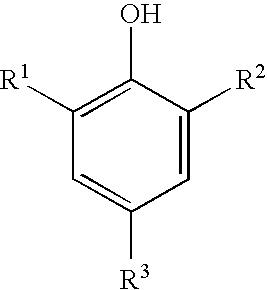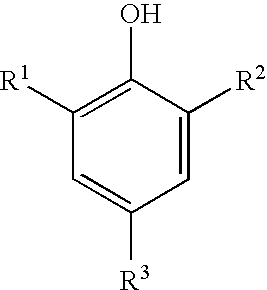1-Bromopropane Having Low Acidity
- Summary
- Abstract
- Description
- Claims
- Application Information
AI Technical Summary
Benefits of technology
Problems solved by technology
Method used
Image
Examples
example 1
[0056]A preparation as described in Comparative Example A was carried out to form a finished 1-bromopropane product. No 2,6-di-tert-butyl-4-methylphenol (BHT) was added during the preparation. Three runs to test the effectiveness of stabilizers in the 1-bromopropane product were carried out. In Runs 1 and 2, an amount of BHT was added to a known amount of the 1-bromopropane product; in Run 3, butylene oxide (abbreviated BOX in Table 1 below) was added to a known amount of 1-bromopropane product. The stability test was performed on all three samples. No 1,2-epoxide was present in Run 1 or in Run 2; Run 3, which did not have any phenol added, is a comparative example. The amount of BHT or butylene oxide (BOX) added to the 1-bromopropane product in each run is listed in Table 1. Results for the 1-bromopropane products initially as well as after 10 days and after 30 days at 60° C. are summarized in Table 1, as amounts present in the 1-bromopropane product.
TABLE 1AmountAmountAmountpresen...
example 2
[0058]The preparation described above in Comparative Example A was carried out to form a finished 1-bromopropane product; in addition, 2,6-di-tert-butyl-4-methylphenol (BHT, 50 kg) was added to the 1-bromopropane product mixture prior to starting the distillation of the organic layer in Step (3); at the end of the distillation, some BHT (˜1000 ppm) was entrained in the purified 1-bromopropane product, as seen by GC. At the end of Step (5), enough butylene oxide was added to the purified 1-bromopropane product to make a butylene oxide concentration of about 450-500 ppm. BHT was detected in the finished 1-bromopropane product by GC, and its area percent indicated 2 ppm BHT was present. The finished 1-bromopropane product was subjected to the acidity test as described above. Results for the finished 1-bromopropane product initially as well as after 10, 12, 25, and 31 days at 60° C. are summarized in Table 2, as amounts present in the finished 1-bromopropane product. The finished 1-brom...
example 3
[0060]A preparation as described in Example 2 was carried out, inclusive of the addition of butylene oxide, to form a finished 1-bromopropane product. The amount of BHT added was 8 g per 1489 g of 1-bromopropane product mixture; no BHT was detected in the 1-bromopropane after the distillation step, nor were any new compounds detected in the 1-bromopropane product mixture by GC. Results for the finished 1-bromopropane product initially as well as after 10 days and after 30 days at 60° C. are summarized in Table 3, as amounts present in the finished 1-bromopropane product. The finished 1-bromopropane product was also subjected to the non-volatile residue test as described above, and the non-volatile residue was 3 ppm.
TABLE 3AmountpresentAmountAmountat start ofpresent afterpresent afterstability test10 days at 60° C.30 days at 60° C.1-Bromopropane99.93%99.93%99.92%2-Bromopropane152ppm152ppm161ppmPropanol4ppm4ppmppmAcidity*3ppm4ppm3.3ppmPropionaldehyde1ppm2ppm1ppmPropionic acid000BHTppm...
PUM
| Property | Measurement | Unit |
|---|---|---|
| Temperature | aaaaa | aaaaa |
| Fraction | aaaaa | aaaaa |
| Fraction | aaaaa | aaaaa |
Abstract
Description
Claims
Application Information
 Login to view more
Login to view more - R&D Engineer
- R&D Manager
- IP Professional
- Industry Leading Data Capabilities
- Powerful AI technology
- Patent DNA Extraction
Browse by: Latest US Patents, China's latest patents, Technical Efficacy Thesaurus, Application Domain, Technology Topic.
© 2024 PatSnap. All rights reserved.Legal|Privacy policy|Modern Slavery Act Transparency Statement|Sitemap



